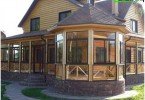A solid foundation for the fence
Not a single private building is complete without a fence enclosing the adjacent territory. For its construction, various materials are used: metal, wood, stone. In order for the fence to be durable and last a long time, it is necessary to equip the foundation for the fence. Only then will your home be protected from any encroachment.
Content
- Types of foundation for the fence
- Tile foundation for solid fencing
- Foundation trench preparation
- Installation and fastening of fittings
- Formwork for forming a concrete base for the fence
- Pouring a concrete monolithic base
Types of foundation for the fence
Depending on the type and design of the fence, the necessary option is chosen. Foundations are:
- tape
- poles;
- tape poles;
- stone.
Before arranging the foundation for the fence, it is necessary to make markings on the ground. Usually a construction plan is a rectangle.
Therefore, the marking is done around the perimeter and is a rope stretched between stakes driven in corners.
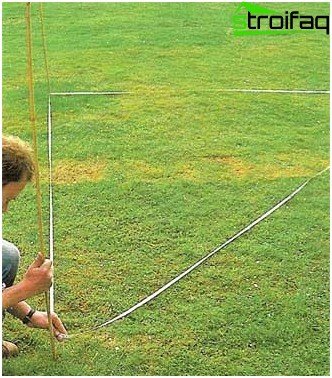
Marking – 1 step for the construction of the foundation for the fence of any type
Tile foundation for solid fencing
Most often, building the foundation for a fence with their own hands, this option is used. It is a reinforced concrete strip laid out around the perimeter. Consider all the stages of the construction of the strip foundation.
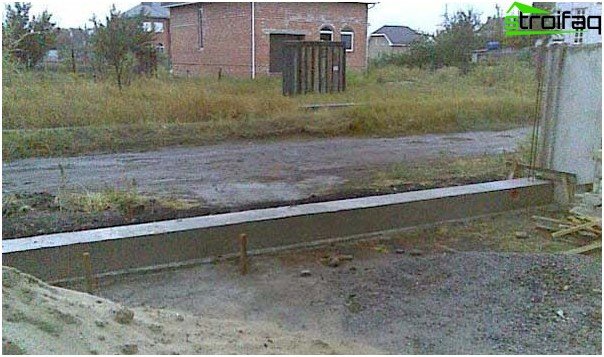
Strip foundation for the fence
Foundation trench preparation
The depth of the trench under the foundation depends on climatic conditions, soil stability and the mass of the structure. Usually it is 60-80 cm. The width of the trench depends on the thickness of the fence itself. Before further work, the bottom of the recess is covered with sand and tamped with plenty of water..
Installation and fastening of fittings
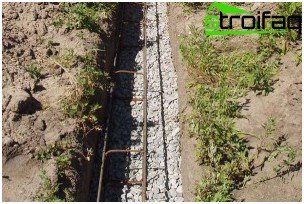
For the strength of the foundation, fittings are needed
To give the strength of the structure, the foundation device for the fence requires the presence of reinforcement. Standard reinforcement for the foundation for the fence has a cross section of 10 mm. It should be laid at a distance of 5 cm from the bottom of the trench. To do this, put some kind of support under the armature. The first two rows of rods are installed along the length of the trench, not reaching the walls of 7 cm. The transverse rods are strengthened together with vertical ones at a distance of 40 cm from each other. Moreover, the vertical racks should be 5-7 cm below the upper cut of the foundation. The top is also fixed with longitudinal rods. The structure is fastened by welding or wire.
Formwork for forming a concrete base for the fence
The formwork is built from a 25-millimeter edged board. Shields are shot down first. A box is formed from the finished structures, given that the top of the foundation should rise 30 cm or more above the ground. Install spacer boards, strengthen shields.
Pouring a concrete monolithic base
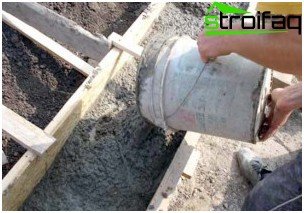
Pouring concrete formwork
The final stage is pouring concrete into the formwork. For the foundation, a mixture of cement and quarry sand is made (1: 4). To improve the strength of the composition, pour out screenings or crushed stone. It should get a thick mass. So that the soil in the trench does not take away moisture from the solution, the bottom of the pit is moistened. After pouring, at least 3 days must pass before you can begin construction of the fence.
Pillar foundation – installation of supports
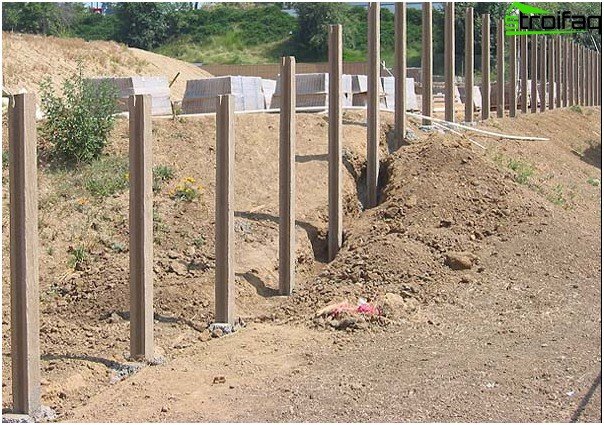
Installed supports for the construction of a pillar foundation
This type of foundation is mainly used for wooden fences or mesh fences, less often of corrugated board. In addition, the pillar foundation for the fence is much easier to execute than other designs and much cheaper. Its use is advisable on heaving soils. The distance between the posts depends on the design of the future fence and ranges from 2 to 3 meters. At such a distance from each other, grooves rummage. For this purpose, a garden drill will fit perfectly.

Screwed foundation posts are also a good option.
The diameter of the recess is determined by the diameter of the pillars plus 15-30 cm. The depth of the pits is 100-150 cm. The bottom of the trench is filled up with 20 cm of sand mixed with crushed stone and merged abundantly with water. The pillars inserted into the recess are aligned strictly vertically with a plumb line or level and poured with sand concrete to ground level. As supports, you can use corners, wood treated with an antiseptic, brick, square metal pipes. To prevent water and snow from getting inside the hollow pillars, plugs are made from above. The result is sturdy pillars that support the cross members..
Combined tape and pole version
Such a foundation is used for a brick fence, mixed (a wooden fence with stone or brick pillars), a fence from corrugated board. According to the marking, a trench is excavated with a width of 20-25 cm, a depth of 0.5 m. After every 2-3 m, recesses are made for the columns of the future support of the fence. The width of these pits should be at least 0.4 m, and the depth below the level of soil freezing, approximately 1.5 m.
Under supports for greater strength, it is desirable to use metal frames. After inserting the column into the pit, the recess is poured with concrete, while the verticality of the support is controlled by a level or plumb. Next, metal reinforcement 8-12 mm thick is laid in the trench and is also poured with concrete to the ground level.
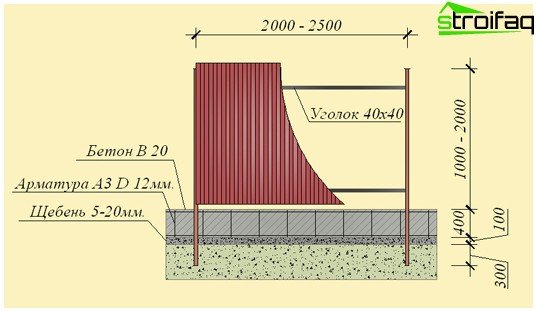
The scheme of the tape and column foundation
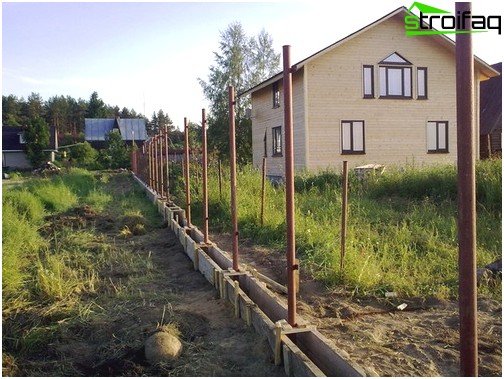
Stage 1 – installation of poles and formwork
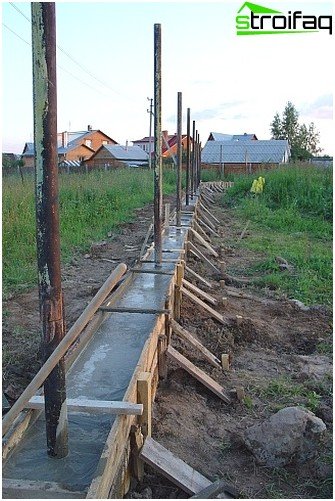
Stage 2 – pouring the foundation and fixing the fence
Stone foundation
The strongest and most reliable stone foundation, used for any fences except for tile and mesh fences. In combination with forged products, the stone foundation has an aesthetic appearance and looks solid. It is very difficult to independently erect such a design. The stones are various in size and have an uneven surface. For those who do not stop difficulties, it is advisable to consult a professional first.
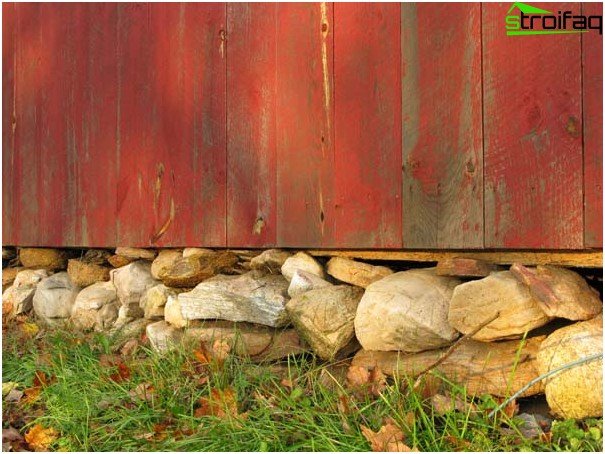
The most difficult process – building a foundation of stone
To make the structure whiter less even, smaller ones are laid out around large stones. And outside the structure, stones with a flat surface are laid. Masonry is performed either dry or using a solution.
The foundation for the fence is no less important detail than the fence itself. The durability of this design depends on taking into account all the factors affecting the strength of the foundation. Namely: subsidence of the base under the action of its own mass, displacement of soil strata, washing with sewage. Therefore, to sleep peacefully, you should correctly choose the type of foundation, use only high-quality materials and comply with the technology.



